On 8 Sep., a webinar with the topic of Impact of Cancelation of Corn Storage
Policy in China was successfully held by CCM. And now, we are here to share all
the details of the webinar to all the visitors.
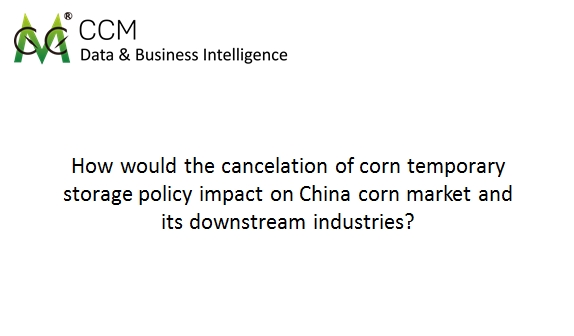
Six parts was shared in our webinar in the following
orders. Brief introduction on corn temporary storage policy
-
Problems caused by corn temporary storage policy
-
Policies to deal with the problems
-
Impact of the policy cancellation on crops’ planting areas
-
Impact on downstream corn processing enterprises and products
-
Expectation
What
exactly is corn temporary storage policy in China?
The policy started in 2008 and ended in 2016.
The Chinese government assigned China Grain
Reserves Corporation to purchase corn from farmers in Northeast China, which
includes Liaoning Province, Jilin Province, Heilongjiang Province, and Inner
Mongolia Autonomous Region. The corn would be purchased at a fixed price. Then China
Grain Reserves Corporation would store the corn temporarily.
In fact, in the beginning, the policy aimed
to help the farmers to buy their corns because the international corn prices
fell a lot in 2008. It is believed that it is a strategy from the Chinese government
to stabilize the farmers.
In the passing nine years, Chinese
government shifted the aim for food security in China by encouraging farmers to
cultivate more corn.
Let’s have a look about the procedures on
how the policy went in the related provinces and region in China.
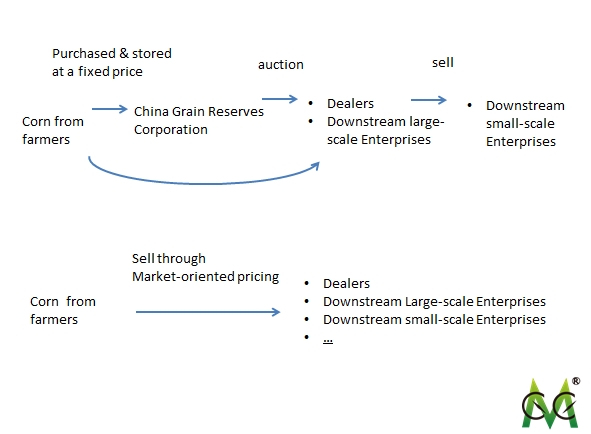
Some corn would be purchased by China Grain
Reserves Corporation.
The corn would by purchased at a fixed
price, and this price would be usually higher the corn prices directly sold to
the downstream market. Because if the purchased prices was lower, the farmers
would not be willing to sell their corn to China Grain Reserves Corporation.
Then the purchased corn would be on an auction
held by China Grain Reserves Corporation and the dealers and downstream
large-scale enterprises would bid on the corn. And some dealers and enterprises
would sell some corn to some small-scale downstream enterprises.
Also, some corn would be directly sold to
the dealers and downstream corn processing enterprises.
This is how the policy went before it got
canceled.
So what happens after the policy is
canceled? Here is what happens.
Corn would not be purchased and stored. The
corn would be more directly sold to the dealers, downstream large-scale enterprises
and small-scale enterprises, which includes the state-owned enterprises of
corn, private corn enterprises and individual corn enterprises. The most
important change would be the corn prices. There is no fix price on corn any
more. The corn price would be based on the market total.
So why the policy would get canceled now?
Because it has caused three serious
problems in corn.
Problem
one: there is too much corn stock in China.
Before the cancellation, there were over
250 million tonnes of corn stock in China.
Here are some graphs to illustrate the problems.
Both the planting areas and output showed an upward trend in the past eight
years.
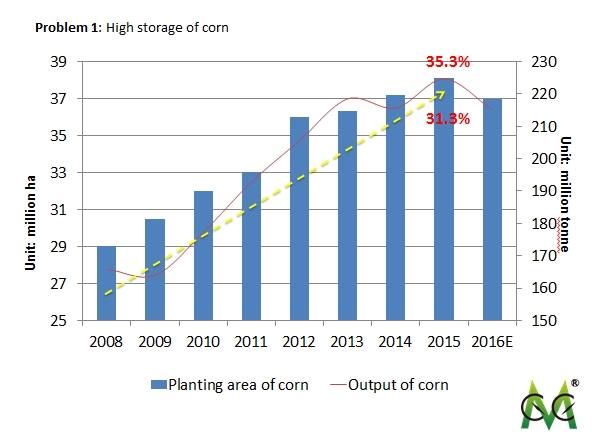
The planting areas of corn were up 31.3% in
2015 compared to that in 2008 and the output of corn was up 35.3% in 2015 than
that in 2008.
Here is another graph to show the corn
purchase volume from 2008 to 2016. It is also an upward trend. The purchase volume
in 2016 was up 249% compared to that in 2009.
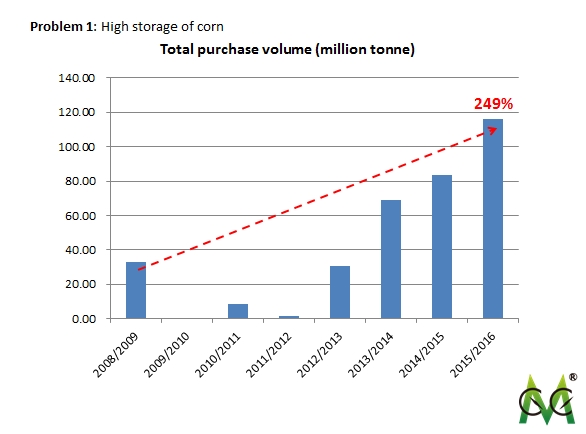
It is actually a vicious circle for the
high corn stock in China.
The corn temporary storage policy had
stabilized the corn price in China at a high price in order to fight against
the price offers by other enterprises. With the high prices, the farmers would
keep planting corn because the government would purchase the corn at a high
price no matter what happens, which caused high output of corn in China then
high corn stock. In the next year, same things happened again.
Problem
two: High output
of corn in China
The output of corn in China kept
increasing. It was up 35.3% in 2015 than that in 2008.
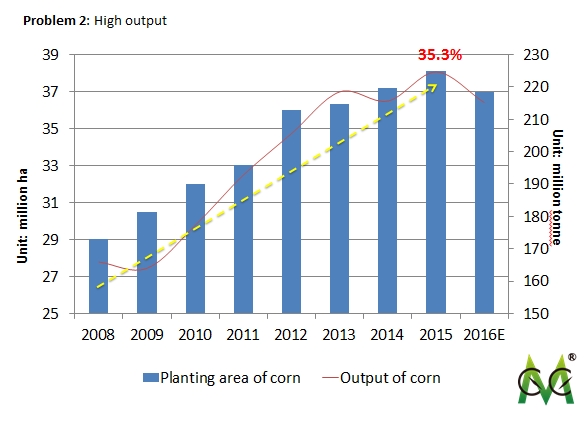
Though the corn output was super high in
China, the import volume of corn still kept increasing in the past few years!
It is such a contradictory and it comes the third problem: high import volume
of corn.
Problem
3: High import volume of corn and other substitute crops
In fact, the high corn price in China and
the lower international corn price pushed the import volume of corn to rise in
2012, up almost 200% compared to that in 2011. And in the following years, the
import volumes of corn stayed high.
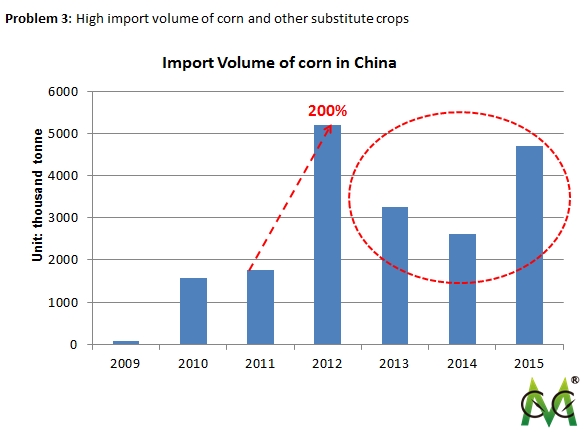
Not only the import volumes of corn
increased, so did corns substitute crops, like DDGS, Sorghum and Barley. You
could see from the graph that all import volumes showed an upward trend in
2013-2015. The import volumes of DDGS was
up 70.4% in 2015 compared to that in 2014; barley, even 900% up and sorghum,
359% increased.
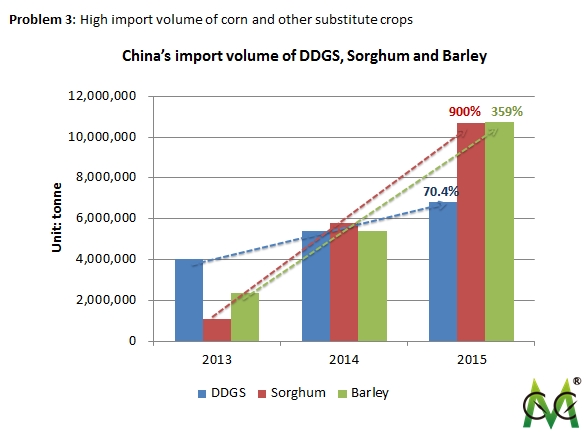
Policies
to tackle the over stock of corn
So, with these three serious problems
caused by the corn temporary storage policy, besides cancelling the policy, the
government has also released some other policies to tackles the over stock of
corn.
In the very beginning, the Chinese government
has released Structure Adjustment Plan on
Corn Planting Area in the ‘Sickle-Shaped Region’ (2016-2020).
Most of the lands are located in Northeast
China and it looks like a sickle.
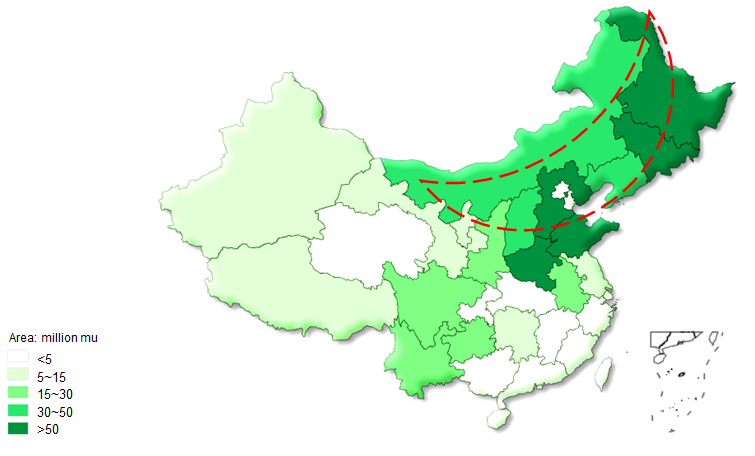
It aims to reduce the total area of land
used for corn cultivation in “sickle-shaped” region by 3.33 million ha over the
next five years in 2020.
The policy is reducing the over stock of
corn from its origin – the planting areas.
And it also aims to cut down the amount of
land used for producing grain corn - corn that can be used for food production
- and convert this land to producing silage corn - corn used only to produce
animal feed.
The policy is reducing the over stock of
corn from its structure.
Later, the Chinese government published National Adjustment Plan of Crop Farming
Structure, according to the policy, the farmers should conduct rotation of
corn with soybean, potato and silage corn.
This is another policy to reduce the over
stock of corn from its structure.
Just in last month, (9 Aug., 2016), China's
Ministry of Finance and State Administration of Taxation issued a notice that
since 1 Sept., 2016, the export tax rebate rate of 10 corn products including
corn starch and corn alcohol will be restored to 13%.
It is known that the rebate rate adjustment
is an important measure to respond to the de-stocking of corn in China.
The policy is to reduce the over stock of
corn from its downstream consumption.
The cancellation of this policy might cause
that the corn price will be decided by market demand and supply, which may
affect the benefits of farmers. However, the government will offer some
subsidies for corn producers.
In order to protect the farmers’ benefit, recently,
the first batch of subsidy fund, up to USD4.49 billion, has been in place. With
USD988 million in Inner Mongolia Autonomous Region, USD688 million in Liaoning
Province, USD1.09 billion in Jilin Province and USD1.736 billion in Heilongjiang
Province.
Possible
change of crops’ planting areas in China
The government has decided to cut the corn
planting area in a large scale, but we think in short term, the planting area
of corn may decrease slowly. There are four main reasons:
At the beginning, some farmers have already
purchased corn seeds earlier, which is unrealistic for them to abandon these
seeds. According to our research, the cost of seed occupies about 12% of the
total cost in planting corn.
Besides, the economic benefits of other
crops are also low. For example, in Nehe, Heilongjiang province in 2015, the
economic benefit of corn is about 300 dollars more than that of soybean in
every hectare.
What’s more, we need to take the
difficulties of changing crops into consideration, because each crop has its
own specialty. And they require different weather conditions, soil
characteristic, capital input and so on.
In the end, some farmers still have
expectations for the policy. Before the official cancellation of the temporary
purchase and storage of corn policy, they expected the state might keep this
policy for one or two more years. Even after the cancellation, they also hope
for the high subsidy for it.
However, from the perspective of long term,
we think the planting areas of other crops are supposed to increase. In
particular, some planting areas, which are not corn-planting dominant region,
could be used for other crops. And the following three ones will be the main
alternatives---Soybean, potato and silage corn.
Why
these three are the main choices?
Soybean
In 2015, China imported more than 80
million tonnes of soybean, accounting for more than 80% of total domestic
consumption. For the state, such huge of import volume in soybean reflects the
imbalance of the agricultural structure, more severely, threating the state’s
food security.
In order to ease the situation, the
government issued the Guiding Opinions on Promoting the Development of Soybean
Planting this year.
China’s Ministry of Agriculture suggests
that up to 2020, the soybean planting area should reach 9.33 million ha in
China, a 2.67 million-ha increase compared with that at present.
So the planting area of soybean is expected
to increase largely in long term.
Potato
Another main change may probably fall on
potato.
As we know, in 2015, China has set potato
as the 4th staple food.
And according to the 13th Five-year Plan
for the Potato Industry (2016-2020), the goal for planting area of potato is
more than 6.67 million ha.
As far as potato is concerned, it enjoys
the features of high nutrition value and good adaptiveness for planting
environment. Therefore, we can expect the growth of potato in China.
Silage
corn
Besides, the share of silage corn is
supposed to grow.
In 2014, only 4.3% of the total corn
produced in China was silage corn, which is an important kind of feed for
livestock.
Chinese government also encouraged more
transformation from grain corn to silage corn in the Structure Adjustment Plan
on Corn Planting Area in the ‘Sickle-Shaped Region’ (2016-2020) and National
Adjustment Plan of Crop Farming Structure (2016-2020)
According to the document, by 2020, the
total planting area of silage corn in China should be 1.67 million ha.
So it can be expected that a large amount
of land will also be converted from producing grain corn to growing silage
corn.
Impact
on downstream corn processing enterprises and products
CCM thinks that the decreasing price of raw
materials, which are related to corn, is the main change for the downstream
enterprises and products.
Since the implementation of temporary
purchase and storage of corn policy in 2008, the price of corn increased year
by year, with the highest average price reaching about 390 dollars per tonne in
2014.
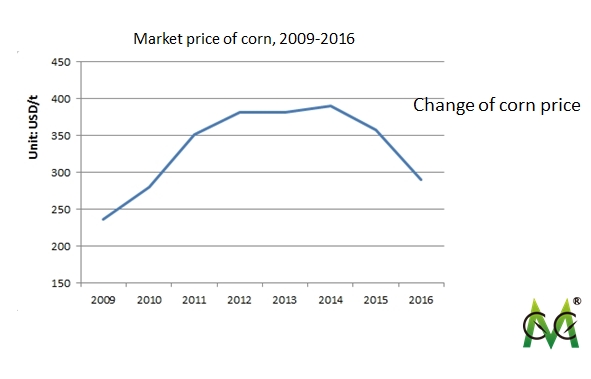
On one hand, we can imagine that how
difficult it is for most corn downstream enterprises. On the other hand, the
state stock volume of corn increased largely. Up to the moment this policy was
cancelled, there were more than 250 million tonnes of corn in stock. In a word,
China’s corn was in an awkward situation of high output, high inventory, high
import volume and high price.
Since July 2015, the corn price has
decreased largely, arriving at 270 dollars per tonne or so at present.
Subsequently, the cost of raw materials for corn downstream enterprises drops.
So naturally, the operating cost of some companies and the price of some
products may bring down.
For example, the following listed
companies, which take corn as their main raw materials, enjoyed lower operating
cost in H1 2016 compared with that in H1 2015 thanks to the reduced price of
corn.
We can see that the cost of Meihua
Bio-technology, Long-live Bio-technology and Dabeinong Group in H1 2016 reduced
by 14.91%, 16.76% and 4.21%, respectively.
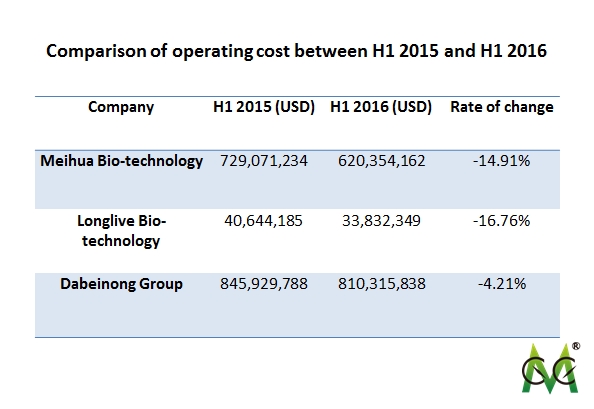
In the following, let’s see the price
trends of some deep-processing products.
From this chart, it’s easy to conclude that
the price of corn starch is relative highly with that of corn. As the corn
price dropped a lot from July 2015, the moving trend of corn starch is similar
to it.
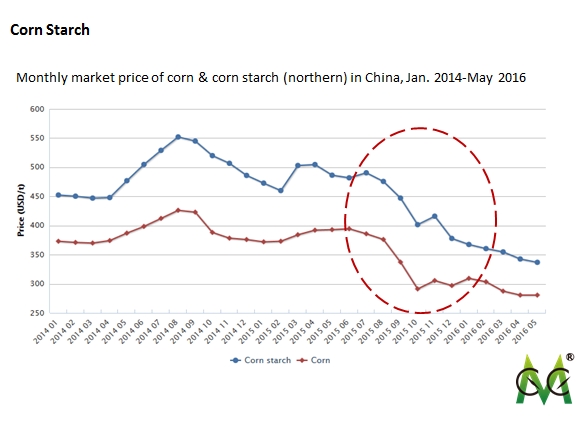
Next, we focus on the monosodium glutamate
(MSG). Within half a year, the price of MSG went down from around 1450 dollars
per tonne in July 2015 to 1100 dollars per tonne or so in December 2015, a drop
of 24.14%.
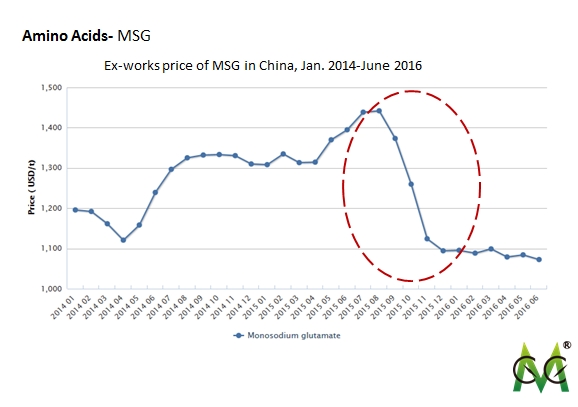
Then, let’s observe the prices of several
sweeteners.
The price of mannitol decreased from about
3500 dollars per tonne in July 2015 to 2500 dollars per tonne in January 2016,
down by more than 28.57% in this period.
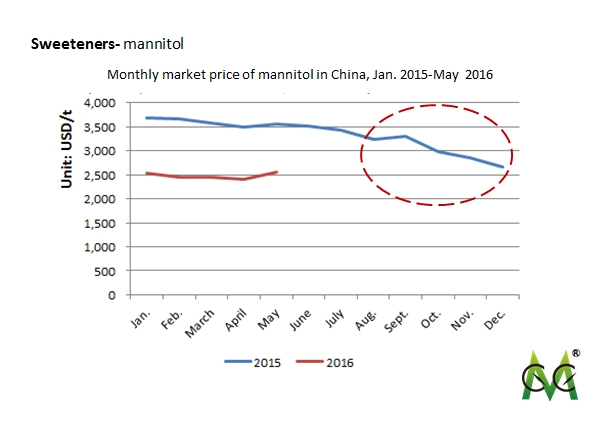
What’s more, the price of HFCS (F55)
experienced a similar trend, down from 510 dollars per tonne or so in August
2015 to about 400 dollars per tonne in April 2016, a drop of 21.57%.
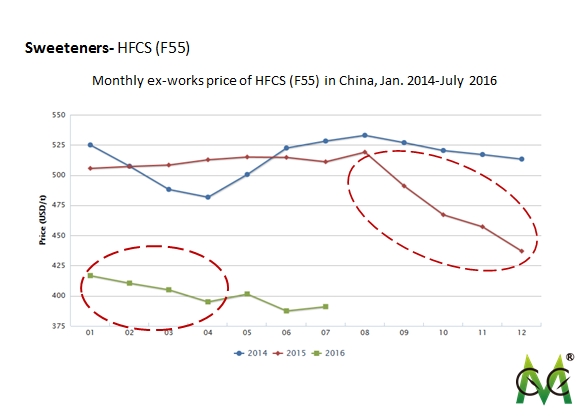
The price of crystalline glucose declined
from 550 dollars per tonne in August 2015 to about 425 dollars per tonne in
April 2016, down by 22.73%.
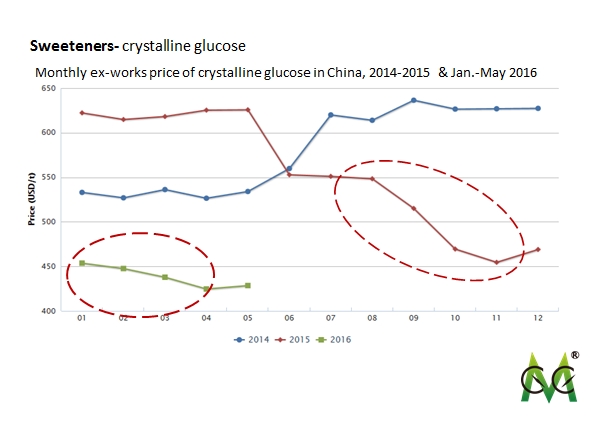
And the price of furfural fell from about
1350 dollars per tonne in October 2015 to 950 dollars per tonne in March 2016,
down by 29.63%.
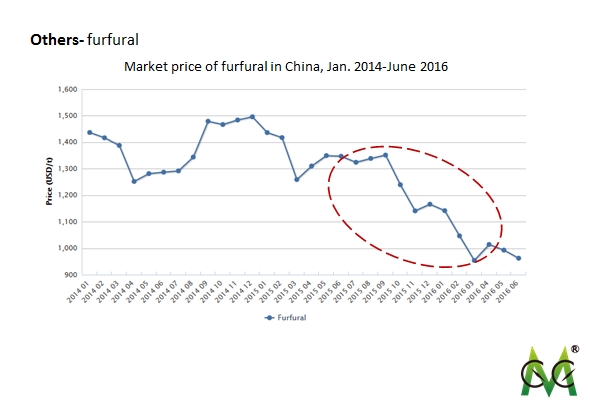
From above examples, we can see the effects
of the cancellation of this policy. Further, what can we expect for the future?
Expectation
Here, we have listed three main
expectations:
1. The price of corn may continue
to decrease with the auction of more stocked corn and the arrival of new corn.
2. China’s import volume of corn
and its substitutes are expected to go down. (Actually, China’s import volume
of corn has decreased by 97.38% YoY in July)
3. Some corn downstream
enterprises may get benefits from the reduced price of raw materials.
* All
the data are sourced from China Customs, China’s Ministry of Agriculture,
annual reports of listed companies and CCM.
If you are interested in our PPT of the
webinar, please email at econtact@cnchemicals.com and our colleague would send you the PPT as soon as possible.
About CCM:
CCM is the leading market intelligence
provider for China’s agriculture, chemicals, food & ingredients and life
science markets. Founded in 2001, CCM offers a range of data and content solutions, from price
and trade data to industry newsletters and customized market research reports. Our clients include Monsanto, DuPont, Shell, Bayer, and Syngenta. CCM is a
brand of Kcomber Inc.